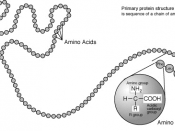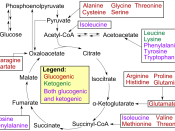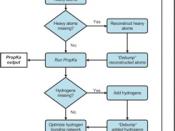Protein, from the Greek proteios, or 'primary', is described as being a large number of amino acids linked by peptide bonds. They are the basis of living organisms account for over 50% of the dry weight of humans. They vary enormously, from the soluble forms found in food to the long fibrous forms used in connective tissues.
All proteins are combinations of about 20 differing amino acids each combined of hydrogen, carbon, nitrogen, oxygen and occasionally sulphur. The amino acids form peptide bonds between each other, thus forming a polypeptide chain. The huge number of possible amino acid combinations and the intricate primary, secondary, tertiary and quaternary structures they form explain why there are just so many different proteins.
The polypeptide chains are arranged and entwined in such a way that the hydrophilic amino acids face outwards in order that they can interact with other structures such as another protein.
Most organisms can only create some of their required amino acids, the rest must be obtained from food. The exception to this is plants, which can manufacture all their required amino acids and therefore proteins through photosynthesis. For adults, the suggested daily intake of protein is 0.79g/kg of body weight. However for children this is doubled and for infants is tripled due to the requirements of rapid growth.
Protein deficiencies can cause diseases, such as Kwashiorkor, a disease found amongst children in the African tropics that wastes the body.
The structures of proteins come into four categories, as mentioned earlier. Firstly, the primary structure, which refers to the linear sequence of amino acids in the chain. Secondly, the secondary structure, which is the coiling and folding of the primary into the 3d forms of the alpha helix and the beta pleated sheet. This shape is formed by hydrogen bonding...



Excellent!
I am thorughly impessed! very well reserched, one small thing- the correct way to descibe an amino acid is comprising of Hydrogen, nitrogen, oxygen, carbon and an "R" group, which is basiclly any set of molecules that attaches in order to specialise the protien ( there is a picture of it on http://www-structure.llnl.gov/Xray/tutorial/protei n_structure.htm) anyway, brilliant!
4 out of 5 people found this comment useful.